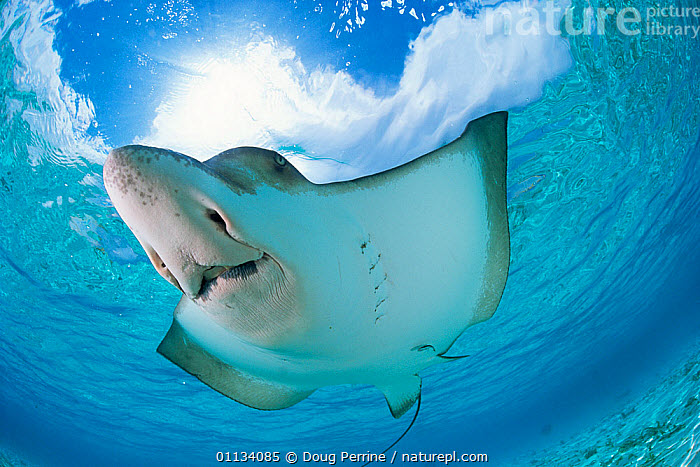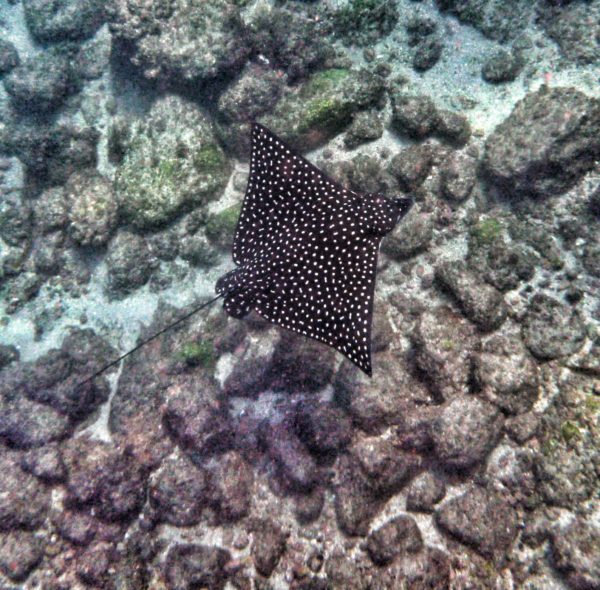Published in the Ocean Watch column, Honolulu Star-Advertiser © Susan Scott
August 26, 2017
A reader named Pat Goding and her West Oahu snorkeling group have become acquainted with a spotted eagle ray that has adjusted to life without its food-finding snout, which has been replaced by a hook. Dubbed Puggy, the plucky ray has
an unusual five stingers on its tail. Courtesy Pat Goding
Last week reader Pat Goding sent several photos of a spotted eagle ray with its snout missing. Part of what looks like a hook protrudes from the ray’s mouth below, and another metal piece sticks up, below the eyes, like a protruding tooth.
But this is not a sad story. It’s the second summer Pat and her snorkeling companions, who call themselves “The West Oahu Swim Posse,” have seen the ray. The plucky fish survived and learned how to live with its disability.
Hawaii hosts only one of the world’s several species of eagle rays. Ours grow 6 feet wide, wingtip to wingtip, with a whiplike tail up to 18 feet long. Eagle rays occasionally cheat death with those long tails. It’s common to see ray tails of various lengths with some even bent, apparently grabbed by their main predators, sharks.
Of all rays, only eagles have more than one stinger on their tails. Some individuals have just one of these defense-only weapons, but others carry up to six. Pat’s flat-faced friend has five.
Six venomous stingers look scary, but we swimmers don’t have to worry about stepping on an eagle ray. Rather than lying on the ocean floor like sting rays, eagle rays rest in a home space, swimming slowly in midwater or near the surface usually in groups of four to six. At mealtime the rays commute to deeper water to dig up some dinner.
Eagle rays have ducklike snouts that jut from below the eyes. Unlike bird beaks, though, the eagle ray’s snout is solid muscle and doesn’t open.
The fish’s mouth is below and behind the snout. Check out several images of an eagle ray’s face by clicking on the image below.

An eagle ray’s snout is for burrowing. Spotted eagle rays find snails and other shelled animals to eat by plowing their snouts through sand. The cloudy water this creates attracts groupie fish hoping to nab a fleeing shrimp or bolting crab.
Watching an eagle ray dig is a breathtaking sight, as is seeing a squadron of these fish flying through the water in synchrony. Eagle rays are fairly common in Hawaii’s waters. I’ve even seen them in the Ala Wai Boat Harbor.
To swim, eagle rays flap their pointed, triangular fins like wings, causing someone long ago to name them after the regal eagles. Ancient Hawaiians noted the rays’ elegance by calling them hihimanu, meaning magnificent. Pat named the flat-faced ray Puggy, after her much-loved pug dog.
About the ray’s ordeal, it seems its hook wounds got infected, the flesh fell away and the snout healed flat. I didn’t think an eagle ray could live without its food-finding snout, but this one seems to be getting by just fine.
Few maimed eagle rays still fly like an eagle or look cute as a puppy, but Puggy Ray is pulling it off. This hihimanu is a magnificent fish indeed.
